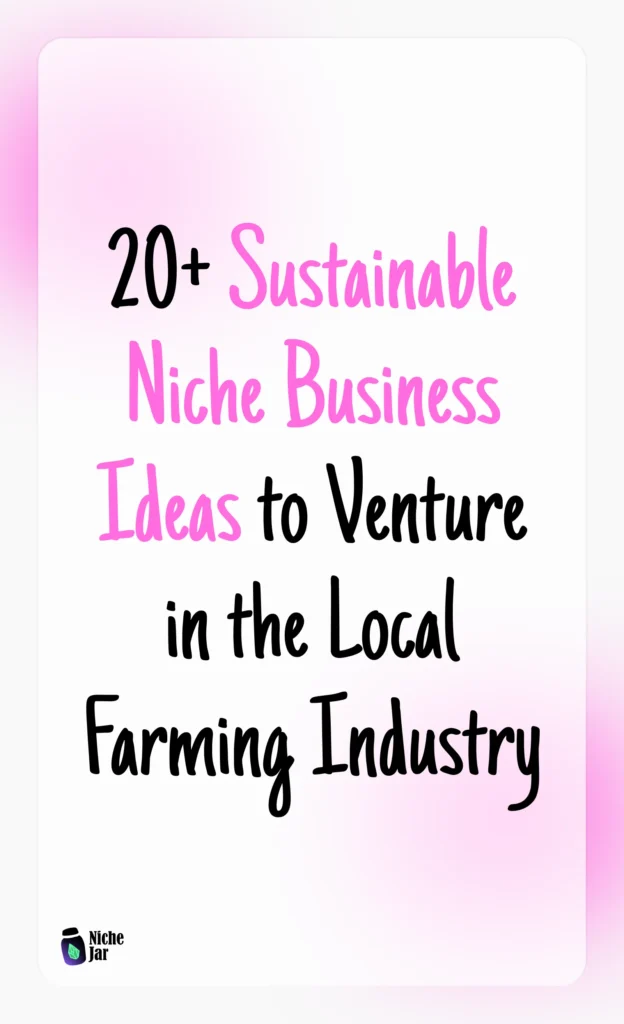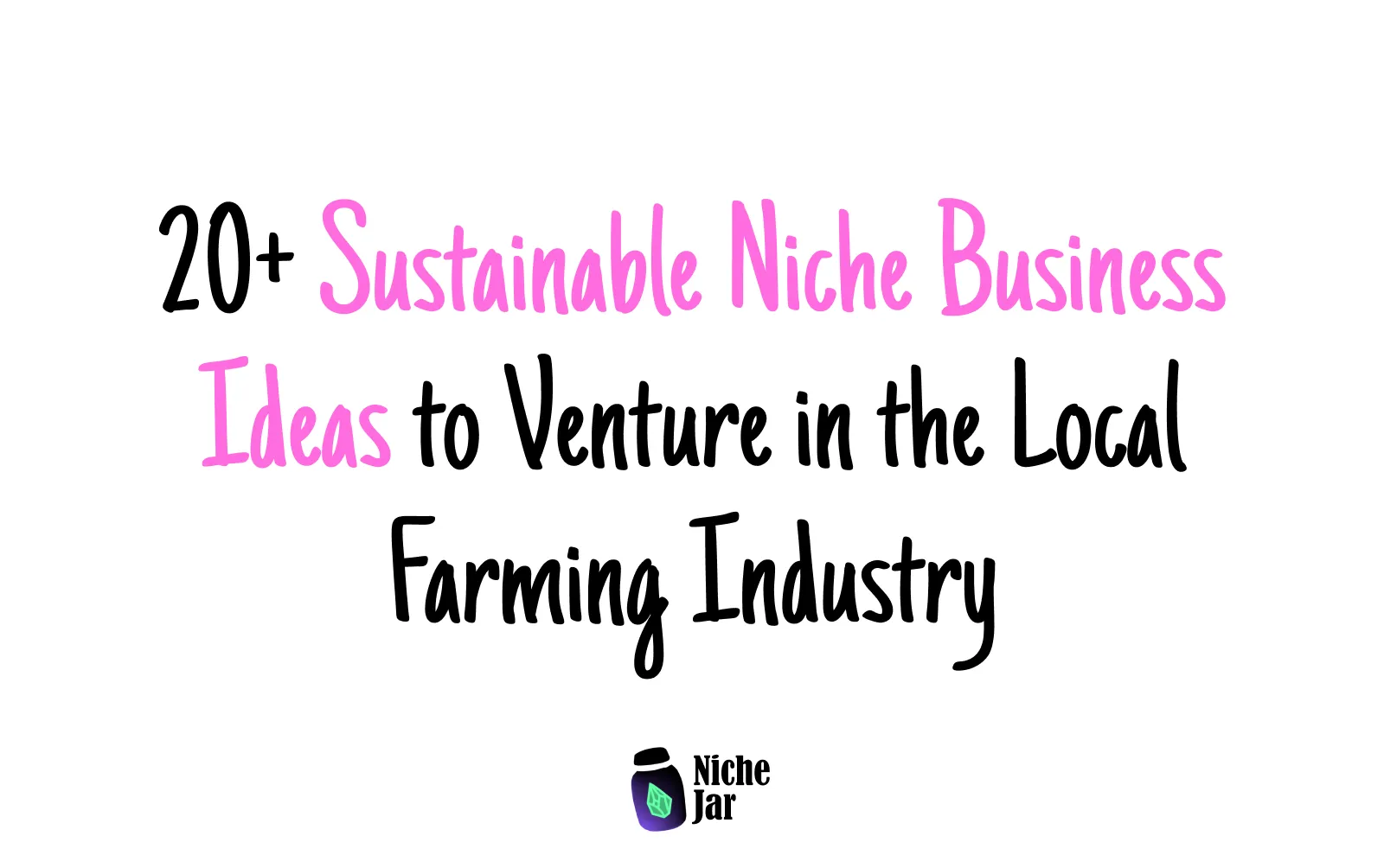- Senia
- 0 Comments
- 506 Views
Have you ever wondered how to build a profitable business while also supporting your community and the planet? Exploring sustainable niche business ideas in the local farming industry might be one of the best ways to do both. From what I’ve seen, this area is full of small but powerful opportunities where everyday people can make money while helping food systems become healthier and more resilient.
The farming industry has always been the backbone of local economies, but in today’s world, people are seeking more than just cheap food. They want sustainability, transparency, and community connection. That’s where niche farming businesses come in.
If you’re someone who has been searching for ways to earn income while making a positive difference, then venturing into sustainable farming niches could be a rewarding path. You don’t necessarily need a large piece of land or decades of experience to start. In fact, many profitable ventures in this space begin small—sometimes with a backyard garden, a handful of chickens, or even just an online platform that connects farmers to local buyers.
I believe this niche matters because it allows ordinary people to create businesses that not only make money but also support local farmers, reduce waste, and encourage healthier lifestyles. Whether you’re looking for low-cost business ideas in farming, creative ways to sell local produce, or even value-added services like agritourism, there’s something here that could work for you.
This post will walk you through 20+ sustainable niche business ideas in the local farming industry, complete with:
- Practical explanations of each idea
- Step-by-step tips to get started
- Estimated startup costs and monetization strategies
- Potential challenges and solutions
- Real-world examples of how these ideas can work
Let’s dive in together and explore which of these could be the right fit for you.
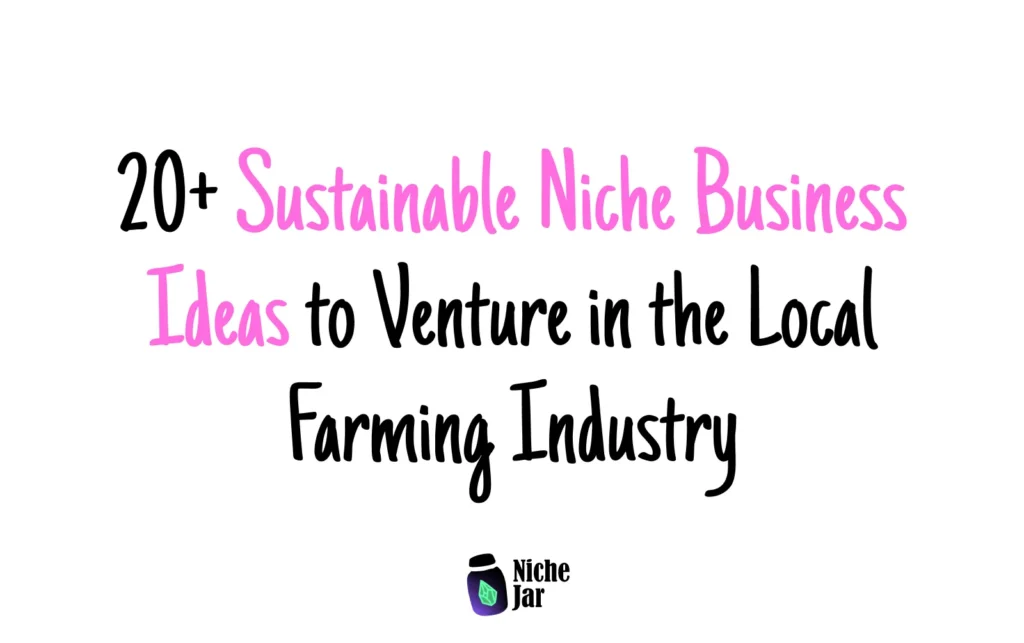
1. Organic Microgreens Farming
Why it’s profitable: Microgreens are highly nutritious, grow quickly (in 7–14 days), and are in demand at restaurants and farmers’ markets.
Steps to start:
- Invest in trays, grow lights, and quality seeds.
- Start small with varieties like sunflower, pea shoots, or radish.
- Sell to local restaurants, farmers’ markets, or via subscription boxes.
Challenges & solutions:
- Challenge: Maintaining consistent quality.
- Solution: Track temperature and humidity closely; invest in good equipment early.
Startup cost: $500–$2,000
Monetization: Direct sales, restaurant contracts, CSA add-ons
Case study: A small grower in Vermont turned a spare room into a microgreens farm and now supplies five restaurants.
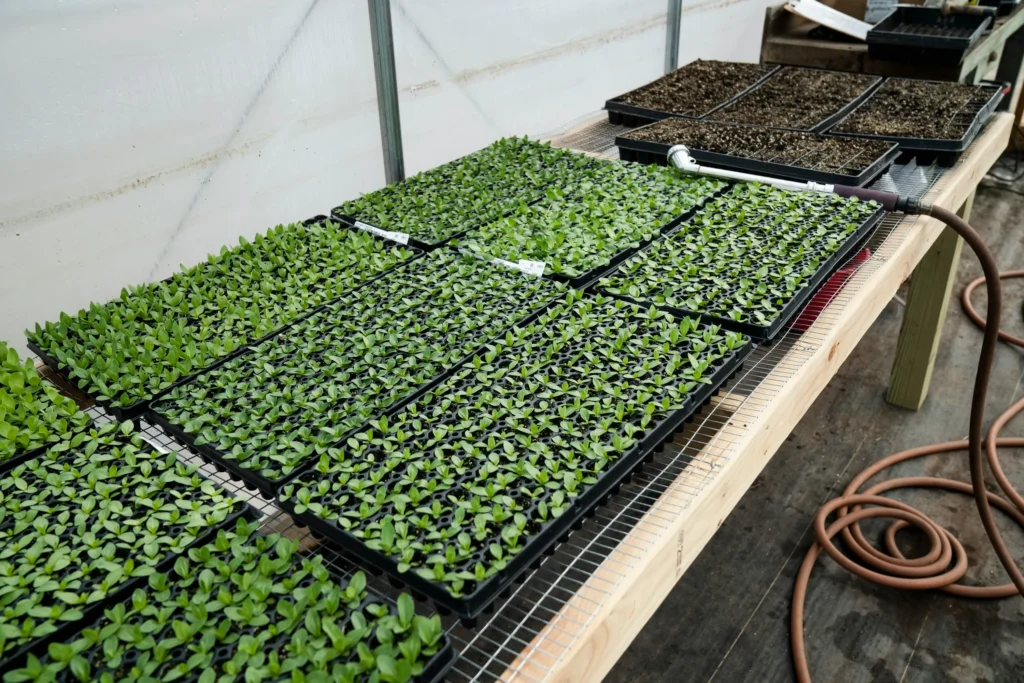
2. Mushroom Cultivation
Why it’s profitable: Mushrooms like oyster and shiitake fetch premium prices and can be grown indoors in small spaces.
Steps to start:
- Buy mushroom spawn and grow kits or logs.
- Maintain controlled humidity with a small tent or room.
- Sell directly at farmers’ markets or to health-conscious consumers.
Challenges & solutions:
- Challenge: Contamination risks.
- Solution: Follow strict cleanliness and sterilization practices.
Startup cost: $1,000–$5,000
Monetization: Direct sales, wholesale to restaurants
Case study: A small farm in Oregon turned a garage into a mushroom operation, earning steady income within months.
3. Beekeeping and Honey Products
Why it’s profitable: Bees provide honey, beeswax, and pollination services. Local honey is always in demand.
Steps to start:
- Take a beekeeping course.
- Buy hives, protective gear, and bees.
- Harvest honey and beeswax to sell raw or as candles, lip balms, etc.
Challenges & solutions:
- Challenge: Hive health issues like mites.
- Solution: Regular inspections and integrated pest management.
Startup cost: $800–$2,500
Monetization: Honey sales, value-added products, pollination services
Case study: A couple in Kansas started with two hives and now run a small honey brand sold at local stores.

4. Pasture-Raised Egg Business
Why it’s profitable: Consumers are increasingly willing to pay more for eggs from chickens raised in humane, pasture-based systems.
Steps to start:
- Set up mobile chicken coops or fencing.
- Source heritage or high-producing breeds.
- Market as free-range, pasture-raised, or organic.
Challenges & solutions:
- Challenge: Predators and weather conditions.
- Solution: Secure fencing and mobile shelters.
Startup cost: $1,000–$5,000
Monetization: Egg sales to local markets, restaurants, or CSA add-ons
Case study: A family farm in Texas started with 50 hens and now supplies local grocers with premium eggs.
5. Urban Rooftop Farming
Why it’s profitable: Rooftops are underused spaces in cities, and urban consumers value hyper-local food.
Steps to start:
- Partner with building owners.
- Install raised beds or hydroponic systems.
- Sell to local restaurants or urban CSAs.
Challenges & solutions:
- Challenge: Infrastructure weight limits.
- Solution: Use lightweight soil mixes and vertical systems.
Startup cost: $2,000–$20,000
Monetization: Direct sales, partnerships with chefs
Case study: A cooperative in New York turned a warehouse roof into a greens farm supplying local groceries.
6. CSA (Community Supported Agriculture) Programs
Why it’s profitable: Customers pay upfront for seasonal shares, giving farmers reliable income.
Steps to start:
- Grow diverse seasonal crops.
- Offer weekly or bi-weekly produce boxes.
- Build trust with clear communication.
Challenges & solutions:
- Challenge: Crop failure risks.
- Solution: Diversify crops and communicate transparently with members.
Startup cost: $3,000–$15,000
Monetization: Subscription memberships
Case study: A small farm in California maintains 100 CSA members year-round, providing steady cash flow.
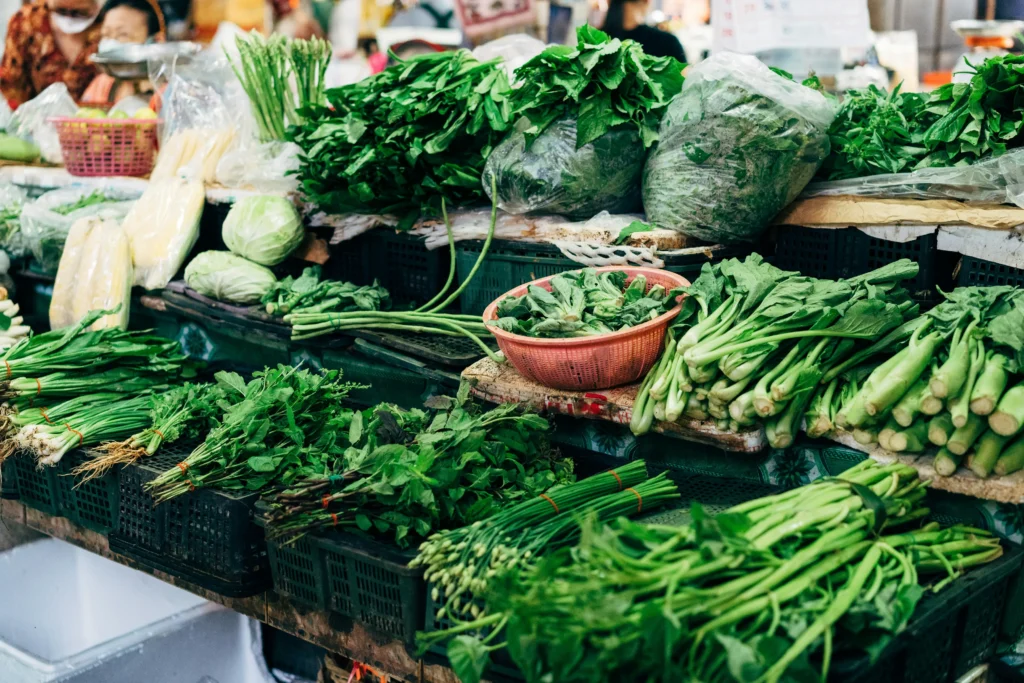
7. Farm-to-Table Meal Kits
Why it’s profitable: Combines convenience of meal kits with the authenticity of farm-fresh produce.
Steps to start:
- Partner with local farms for ingredients.
- Create simple recipe cards.
- Market online with local delivery.
Challenges & solutions:
- Challenge: Logistics of delivery.
- Solution: Focus on small geographic areas at first.
Startup cost: $5,000–$20,000
Monetization: Subscription kits, online orders
Case study: A startup in Oregon built a niche by offering seasonal meal kits sourced entirely within 50 miles.
8. Goat Milk and Cheese Production
Why it’s profitable: Goat milk products are popular among people with lactose intolerance. Artisan cheeses fetch high prices.
Steps to start:
- Raise goats and learn milking practices.
- Acquire licenses for dairy production.
- Sell at farmers’ markets and specialty shops.
Challenges & solutions:
- Challenge: Regulatory hurdles.
- Solution: Start with raw goat milk soap to enter market before scaling into dairy.
Startup cost: $10,000–$50,000
Monetization: Milk, cheese, yogurt, soap
Case study: A homestead in Wisconsin grew from selling raw milk to running a goat cheese creamery.
9. Aquaponics Farming
Why it’s profitable: Combines fish farming with hydroponics—minimal water use, high yields.
Steps to start:
- Build tanks for fish and grow beds for plants.
- Balance water chemistry.
- Sell both fish and produce locally.
Challenges & solutions:
- Challenge: High initial learning curve.
- Solution: Start small with DIY systems before scaling.
Startup cost: $5,000–$30,000
Monetization: Fish + produce sales
Case study: A Florida business supplies tilapia and greens to nearby restaurants.

10. Herbal Teas and Medicinal Plants
Why it’s profitable: Herbal teas and remedies are part of a growing wellness trend.
Steps to start:
- Grow herbs like chamomile, mint, or lemon balm.
- Dry and package teas.
- Sell at health stores and online.
Challenges & solutions:
- Challenge: Compliance with health claims.
- Solution: Market as lifestyle/wellness teas without medical promises.
Startup cost: $500–$5,000
Monetization: Loose-leaf tea, tea bags, herbal blends
Case study: A small herbalist in Vermont sells tea subscriptions online.
11. Pickling and Fermented Foods
Why it’s profitable: Fermented foods like kimchi and sauerkraut are trendy for gut health.
Steps to start:
- Grow cucumbers, cabbage, or radishes.
- Use certified kitchens for processing.
- Package in eco-friendly jars.
Challenges & solutions:
- Challenge: Regulatory standards.
- Solution: Use shared community kitchens for compliance.
Startup cost: $1,000–$10,000
Monetization: Jars of pickles, wholesale to health stores
Case study: A couple in Colorado grew cucumbers and built a fermented foods brand at local markets.
12. Edible Flower Farming
Why it’s profitable: Restaurants and bakeries pay premium prices for edible flowers like nasturtium and pansies.
Steps to start:
- Grow seasonal flowers organically.
- Market to chefs, caterers, and florists.
- Sell packaged in small eco-containers.
Challenges & solutions:
- Challenge: Fragile shelf life.
- Solution: Offer just-in-time harvesting and deliveries.
Startup cost: $500–$3,000
Monetization: Wholesale to restaurants, event caterers
Case study: A grower in California sells edible flowers to high-end bakeries.

13. Sustainable Poultry Farming
Why it’s profitable: Pasture-raised chickens and turkeys are in high demand for ethical meat.
Steps to start:
- Raise small flocks in mobile coops.
- Use rotational grazing for sustainability.
- Sell directly to customers or via CSA.
Challenges & solutions:
- Challenge: Feed costs.
- Solution: Supplement with local grain partnerships.
Startup cost: $3,000–$15,000
Monetization: Meat sales, restaurant contracts
Case study: A farm in Kentucky runs seasonal pasture-raised turkey sales for Thanksgiving.
14. Local Grain Milling
Why it’s profitable: Small-scale mills can supply fresh flour to artisan bakers.
Steps to start:
- Source heritage or organic grains.
- Invest in a small mill.
- Sell flour to local bakeries or directly.
Challenges & solutions:
- Challenge: Machinery cost.
- Solution: Start with community-shared mills or cooperatives.
Startup cost: $10,000–$50,000
Monetization: Flour sales, baking mixes
Case study: A co-op in Oregon mills heritage wheat and sells flour subscriptions.
15. Composting and Soil Products
Why it’s profitable: Gardeners and farmers need high-quality compost and soil blends.
Steps to start:
- Collect food scraps or farm waste.
- Build compost bins or windrows.
- Package and sell compost or worm castings.
Challenges & solutions:
- Challenge: Odor management.
- Solution: Use proper ratios and cover systems.
Startup cost: $1,000–$10,000
Monetization: Bagged compost, bulk sales to farms
Case study: A startup in Ohio built a compost subscription model with weekly pick-ups.

16. Seed Saving and Selling
Why it’s profitable: Gardeners and small farms value organic, non-GMO seeds.
Steps to start:
- Grow open-pollinated crops.
- Harvest and clean seeds.
- Package and sell online or at markets.
Challenges & solutions:
- Challenge: Cross-pollination issues.
- Solution: Follow seed-saving best practices for isolation.
Startup cost: $500–$3,000
Monetization: Seed packets, online stores
Case study: A farmer in New Mexico built a side business selling heirloom chili pepper seeds.
17. Farm Education Workshops
Why it’s profitable: Many people want to learn homesteading, gardening, or sustainable living skills.
Steps to start:
- Identify your expertise (gardening, composting, etc.).
- Host small group workshops.
- Charge fees or offer memberships.
Challenges & solutions:
- Challenge: Seasonal attendance.
- Solution: Record online courses for year-round income.
Startup cost: $500–$5,000
Monetization: Ticket sales, online classes
Case study: A farmer in Maine runs seasonal cheese-making and gardening workshops.
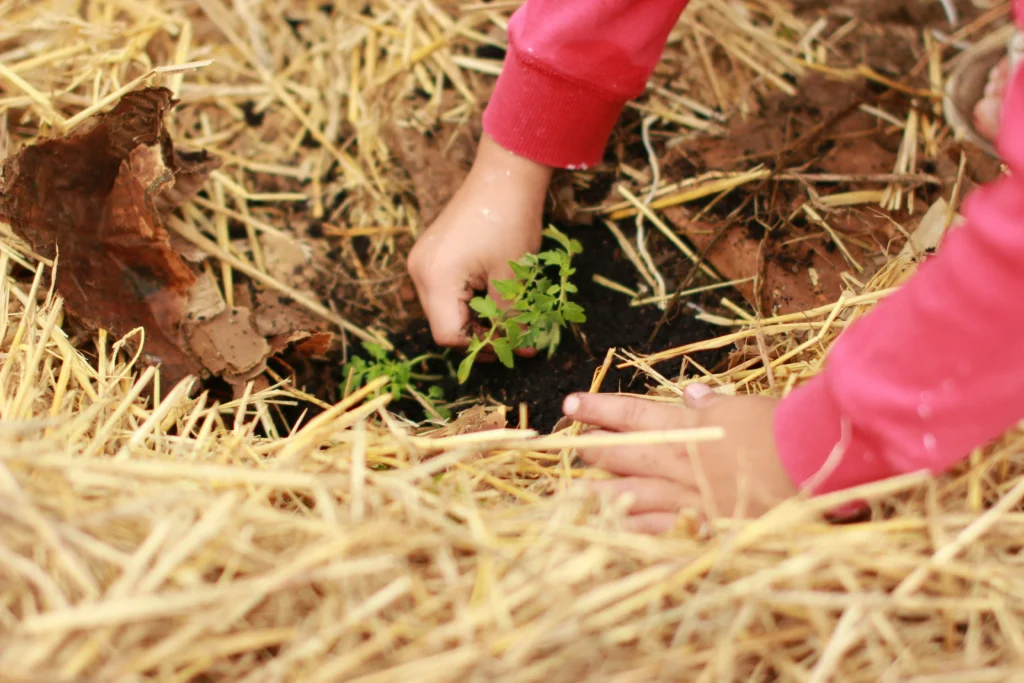
18. Agritourism Experiences
Why it’s profitable: Visitors pay for farm tours, events, and immersive rural experiences.
Steps to start:
- Offer farm tours or seasonal events (pumpkin patches, hayrides).
- Partner with local tourism boards.
- Market online and via social media.
Challenges & solutions:
- Challenge: Liability concerns.
- Solution: Insurance and clear safety measures.
Startup cost: $2,000–$20,000
Monetization: Tour tickets, events, farm stays
Case study: A vineyard in Italy offers agritourism packages combining wine tasting with farm tours.
19. Specialty Fruit Farming
Why it’s profitable: Unique fruits like figs, pawpaw, or elderberries fetch premium prices.
Steps to start:
- Select climate-appropriate specialty crops.
- Market directly to chefs and niche consumers.
- Offer U-pick options for added revenue.
Challenges & solutions:
- Challenge: Long growth times.
- Solution: Start with faster-maturing varieties.
Startup cost: $5,000–$25,000
Monetization: Fresh fruit sales, value-added products
Case study: A grower in Ohio specializes in elderberries for both fresh and syrup sales.
20. Hydroponic Greens Business
Why it’s profitable: Year-round production of lettuce and herbs with high yields in small spaces.
Steps to start:
- Invest in hydroponic systems (NFT, DWC).
- Start with fast-growing lettuce and basil.
- Sell via subscription, CSA, or restaurants.
Challenges & solutions:
- Challenge: Energy costs.
- Solution: Use LED lights and energy-efficient systems.
Startup cost: $5,000–$50,000
Monetization: Restaurant contracts, direct sales
Case study: A warehouse farm in Chicago supplies local restaurants year-round with fresh greens.

21. Farm-Based Subscription Boxes
Why it’s profitable: Bundles local farm products into recurring sales.
Steps to start:
- Curate products (eggs, honey, jams).
- Build subscription website.
- Deliver monthly or seasonal boxes.
Challenges & solutions:
- Challenge: Logistics of packaging and delivery.
- Solution: Start local and grow gradually.
Startup cost: $2,000–$10,000
Monetization: Recurring subscription income
Case study: A collective of farms in Canada sells regional “farm share boxes” online.
22. Mobile Farmers Market Truck
Why it’s profitable: Brings local food directly to neighborhoods, schools, and workplaces.
Steps to start:
- Outfit a truck with refrigeration.
- Partner with local farms.
- Build weekly routes in food deserts or busy areas.
Challenges & solutions:
- Challenge: Licensing and permits.
- Solution: Work closely with local municipalities for approvals.
Startup cost: $20,000–$75,000
Monetization: Direct sales, partnerships with farms
Case study: A nonprofit in Detroit runs a mobile market truck that brings fresh produce to underserved areas.
Starting a sustainable farming niche business doesn’t mean you need acres of land or huge investments. From what I’ve seen, many of the most successful ventures begin with a small idea, steady effort, and a willingness to adapt.
In this guide, we’ve explored over 20 ways you can turn local farming into a profitable and meaningful business. Whether it’s growing mushrooms in a garage, raising chickens for eggs, or hosting farm tours, each idea carries potential if matched with your passion and resources.
Remember, every journey starts small. You don’t need to have it all figured out right away. Take one step—research your local market, connect with other farmers, or experiment with a small crop. Over time, small efforts can grow into something lasting.
If you found this useful, I’d encourage you to explore other niche guides on Nichejar.com. And if you have ideas or experiences of your own, feel free to share them—we’re all learning together.
TLDR
In short:
- Microgreens farming – Quick turnaround, low space needs, steady demand.
- Mushroom cultivation – High-value crop, small-space friendly.
- Beekeeping – Honey, beeswax, and pollination services.
- CSA programs – Steady income from local subscribers.
- Farm-to-table meal kits – Combine local produce with convenience.
- Agritourism – Farm tours, events, and workshops.
- Hydroponic greens – Year-round growing in controlled environments.
